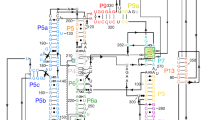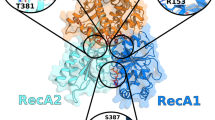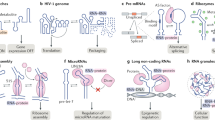Abstract
We have probed the nature of the individual kinetic steps in the folding of the Tetrahymena ribozyme by studying the folding kinetics of mutant ribozymes. After rapid formation of the first structural subdomain, a slow step precedes stable formation of the second subdomain. The two central helices of the second subdomain form in an interdependent manner, and this structural subunit therefore also constitutes a kinetic folding unit. The slow folding step includes formation of tertiary interactions in a triple-helical scaffold that orients the two subdomains of the RNA. The rapid and early formation of short range secondary structure, the hierarchical formation of kinetic folding units corresponding to structural subdomains, and the formation of tertiary interactions between subdomains late during the folding process appear to be common features of the folding mechanism for both RNA and proteins.
This is a preview of subscription content, access via your institution
Access options
Subscribe to this journal
Receive 12 print issues and online access
$189.00 per year
only $15.75 per issue
Buy this article
- Purchase on Springer Link
- Instant access to full article PDF
Prices may be subject to local taxes which are calculated during checkout
Similar content being viewed by others
References
Pyle, A.M. & Green, J.B. RNA folding. Curr. Opin. Struct. Biol. 5, 303–310 (1995).
Shen, L.X., Cai, Z. & Tinoco, I., jr. RNA structure at high resolution. FASEB J. 9, 1023–1033 (1995).
Banerjee, A.R. & Turner, D.H. The time dependence of chemical modification reveals slow steps in the folding of a group I ribozyme. Biochemistry 34, 6504–6512 (1995).
Bassi, G.S., MØIIegaard, N.-E., Murchie, A.I.H., von Kitzing, E. & Lilley, D.M.J. Ionic interactions and the global conformations of the hammerhead ribozyme. Nature Struct. Biol. 2, 45–55 (1995).
Celander, D.W. & Cech, T.R. Visualizing the higher order folding of a catalytic RNA molecule. Science 251, 401–407 (1991).
Herschlag, D. RNA chaperones and the RNA folding problem. J. Biol. Chem. 270, 20871–20874 (1995).
Jaeger, L., Westhof, E. & Michel, F. Monitoring of the cooperative unfolding of the sunY group I intron of bacteriophage T4. The active form of the sunY ribozyme is stabilized by multiple interactions with 3′ terminal intron components. J. Mol. Biol. 234, 331–346 (1993).
Laggerbauer, B., Murphy, F.L. & Cech, T.R. Two major tertiary folding transitions of the Tetrahymena catalytic RNA. EMBO J. 13, 2669–2676 (1994).
Ma, C.K. et al. Control of translation by mRNA secondary structure: the importance of the kinetics of structure formation. Mol. Microbiol. 14, 1033–1047 (1994).
Pan, T. Higher order folding and domain analysis of the ribozyme from Bacillus subtilis ribonuclease P. Biochemistry 34, 902–909 (1995).
Weeks, K.M. & Cech, T.R. Protein facilitation of group I intron splicing by assembly of the catalytic core and the 5′ splice site domain. Cell 82, 221–230 (1995).
Weeks, K.M. & Cech, T.R. Assembly of a ribonucleoprotein catalyst by tertiary structure capture. Science 271, 345–348 (1996).
Zarrinkar, P.P. & Williamson, J.R. Kinetic intermediates in RNA folding. Science 265, 918–924 (1994).
Zarrinkar, P.P. & Williamson, J.R. The P9.1-P9.2 peripheral extension helps guide folding of the Tetrahymena ribozyme. Nucleic Acids Res. 24, 854–858 (1996).
Cech, T.R. Structure and mechanism of the large catalytic RNAs: group I and group II introns and ribonuclease P. in The RNA World (eds Gesteland, R.F. & Atkins, J.F.) 239–269 (Cold Spring Harbor Laboratory Press, Cold Spring Harbor, NY, 1993).
Cech, T.R., Damberger, S.H. & Gutell, R.R. Representation of the secondary and tertiary structure of group I introns. Nature Struct. Biol. 1, 273–280 (1994).
Michel, F. & Westhof, E. Modelling of the three-dimensional architecture of group I catalytic introns based on comparative sequence analysis. J. Mol. Biol. 216, 585–610 (1990).
Doudna, J.A. & Cech, T.R. Self-assembly of a group I intron active site from its component tertiary structural domains. RNA 1, 36–45 (1995).
Murphy, F.L. & Cech, T.R. An independently folding domain of RNA tertiary structure within the Tetrahymena ribozyme. Biochemistry 32, 5291–5300 (1993).
Nakamura, T.M., Wang, Y.-H., Zaug, A.J., Griffith, J.D. & Cech, T.R. Relative orientation of RNA helices in a group I ribozyme determined by helix extension electron microscopy. EMBO J. 14, 4849–4859 (1995).
Wang, Y.-H., Murphy, F.L., Cech, T.R. & Griffith, J.D. Visualization of a tertiary structural domain of the Tetrahymena group I intron by electron microscopy. J. Mol. Biol. 236, 64–71 (1994).
Burke, J.M. et al. Role of conserved sequence elements 9L and 2 in self-splicing of the Tetrahymena ribosomal RNA precursor. Cell 45, 167–176 (1986).
Williamson, C.L., Tierney, W.M., Kerker, B.J. & Burke, J.M. Site-directed mutagenesis of core sequence elements 9R′, 9L, 9R and 2 in self-splicing Tetrahymena pre-rRNA. J. Biol. Chem. 262, 14672–14682 (1987).
Michel, F., Ellington, A.D., Couture, S. & Szostak, J.W. Phylogenetic and genetic evidence for base-triples in the catalytic domain of group I introns. Nature 347, 578–580 (1990).
Green, R. & Szostak, J.W. In vitro genetic analysis of the hinge region between helical elements P5-P4-P6 and P7-P3-P8 in the sunY group I self-splicing intron. J. Mol. Biol. 235, 140–155 (1994).
Chastain, M. & Tinoco, I., jr. Nucleoside triples from the group I intron. Biochemistry 32, 14220–14228 (1993).
Herschlag, D. & Cech, T.R. Catalysis of RNA cleavage by the Tetrahymena thermophila ribozyme. 1. Kinetic description of the reaction of an RNA substrate complementary to the active site. Biochemistry 29, 10159–10171 (1990).
McConnell, T.S., Cech, T.R. & Herschlag, D. Guanosine binding to the Tetrahymena ribozyme: thermodynamic coupling with oligonucleotide binding. Proc. Natl. Acad. Sci. USA 90, 8362–8366 (1993).
Murphy, F.L. & Cech, T.R. GAAA tetraloop and conserved bulge stabilize tertiary structure of a group I intron domain. J. Mol. Biol. 236, 49–63 (1994).
Mohr, G., Zhang, A., Gianelos, J.A., Belfort, M. & Lambowitz, A.M. The Neurospora CYT-18 protein suppresses defects in the phage T4 td intron by stabilizing the catalytically active structure of the intron core. Cell 69, 483–494 (1992).
Christensen, H. & Pain, R.H. The contribution of the molten globule model. in Mechanisms of Protein Folding (ed. Pain, R.H.) 55–79 (Oxford University Press, New York, 1994).
Lynch, D.C. & Schimmel, P.R. Cooperative binding of magnesium to transfer ribonucleic acid studied by a fluorescent probe. Biochemistry 13, 1841–1852 (1974).
Stein, A. & Crothers, D.M. Conformational changes of transfer RNA. The role of magnesium(II). Biochemistry 15, 160–168 (1976).
Westhof, E. & Michel, F. Some tertiary motifs of RNA foldings. in Structural Tools for the Analysis of Protein-Nucleic Acid Complexes (eds Lilley, D.J.M., Heumann, H. & Suck, D.) 255–267 (Birkhäuser Verlag, Basel, 1992).
Bai, Y., Sosnick, T., Mayne, L. & Englander, S.W. Protein folding intermediates: native-state hydrogen exchange. Science 269, 192–197 (1995).
Dobson, C.M. Finding the right fold. Nature Struct. Biol. 2, 513–517 (1995).
Dobson, C.M., Evans, P.A. & Radford, S.E. Understanding how proteins fold: the lysozyme story so far. TIBS 19, 31–37 (1994).
Jennings, P.A. & Wright, P.E. Formation of a molten globule intermediate early in the kinetic folding pathway of apomyoglobin. Science 262, 892–896 (1993).
López-Hernandez, E. & Serrano, L. Structure of the transition state for folding of the 129 aa protein CheY resembles that of a smaller protein, CI–2. Folding & Design 1, 43–55 (1996).
Serrano, L., Matouschek, A. & Fersht, A.R. The folding of an enzyme VI. The folding pathway of barnase: comparison with theoretical models. J. Mol. Biol. 224, 847–859 (1992).
Wu, L.C., Peng, Z.-y. & Kim, P.S. Bipartite structure of the α-lactalbumin molten globule. Nature Struct. Biol. 2, 281–286 (1995).
Loh, S.N., Kay, M.S. & Baldwin, R.L. Structure and stability of a second molten globule intermediate in the apomyoglobin folding pathway. Proc. Natl. Acad. Sci. USA 92, 5446–5450 (1995).
Higuchi, R. Recombinant PCR. in PCR Protocols: A Guide to Methods and Applications (eds Innis, M.A. et al.) 177–183 (Academic Press Inc., New York, 1990).
Zaug, A.J., Grosshans, C.A. & Cech, T.R. Sequence-specific endoribonuclease activity of the Tetrahymena ribozyme: enhanced cleavage of certain oligonucleotide substrates that form mismatched ribozyme-substrate complexes. Biochemistry 27, 8924–8931 (1988).
Author information
Authors and Affiliations
Rights and permissions
About this article
Cite this article
Zarrinkar, P., Williamson, J. The kinetic folding pathway of the Tetrahymena ribozyme reveals possible similarities between RNA and protein folding. Nat Struct Mol Biol 3, 432–438 (1996). https://doi.org/10.1038/nsb0596-432
Received:
Accepted:
Issue Date:
DOI: https://doi.org/10.1038/nsb0596-432



